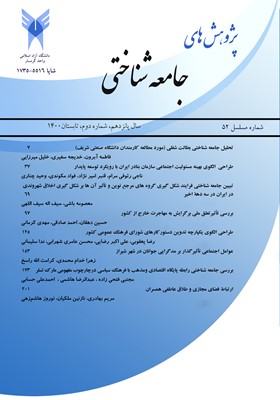طراحی الگوی یکپارچه تدوین دستورکارهای شورای فرهنگ عمومی کشور
محورهای موضوعی : در این فصلنامه موضوعات جامعه شناختی در اولویت چاپ هستند و موضوعات نزدیک به جامعه شناسی در اولویتهای بعد قرار می گیرند
رضا یعقوبی
1
![]() ,
علی اکبر رضائی
2
,
محسن عامری شهرابی
3
,
ندا سلیمانی
4
,
علی اکبر رضائی
2
,
محسن عامری شهرابی
3
,
ندا سلیمانی
4
1 - دانشجوی دکتری رشته مدیریت امور فرهنگی، دانشکده مدیریت و اقتصاد ، واحد علوم و تحقیقات، دانشگاه آزاد اسلامی ، تهران، ایران
2 - استادیار و عضو هیات علمی دانشکده مدیریت و اقتصاد، واحد علوم و تحقیقات، دانشگاه آزاد اسلامی ، تهران، ایران
3 - استادیار و عضو هیات علمی گروه مدیریت، واحد نراق، دانشگاه آزاد اسلامی، استان مرکزی، ایران.
4 - استادیار و عضو هیات علمی ، واحد تبریز، دانشگاه آزاد اسلامی، آذربایجان شرقی، ایران.
کلید واژه:
چکیده مقاله :
پژوهش حاضر با هدف ارائه الگوی یکپارچه سازی تدوین دستورکارهای شورای فرهنگ عمومی انجام شده است. پژوهش از نظر هدف کاربردی؛ از نظر داده ها، آمیخته اکتشافی و از نظر ماهیت به روش پیمایشی مقطعی و بر مبنای نظریه داده بنیاد بود. جامعه آماری مرحله کیفی خبرگان در حوزه قلمرو موضوعی تحقیق بودند که به روش هدفمند و گلوله برفی نمونه گیری شد. جامعه مرحله کمی اعضا و دست اندرکاران شورای فرهنگ عمومی و شورای عالی انقلاب فرهنگی در حال و گذشته و تعدادی از مدیران و کارشناسان وزارت فرهنگ و ارساد اسلامی به تعداد 340 نفر بود که بر اساس فرمول کوکران حجم نمونه 180 نفر تعیین و به روش تصادفی طبقه ای نمونه گیری شد. ابزار جمع آوری اطلاعات مرحله کیفی، اسناد و مدارک و مصاحبه دلفی بود و در بخش کمی پرسشنامه بود. به منظور روایی ابزار از روایی صوری و محتوایی و برای تعیین پایایی ابزار از آلفای کرونباخ استفاده شد. روش تحلیل دادههای کیفی کدگذاری باز، محوری و انتخابی بود و برای تحلیل داده های کمی از آزمون تحلیل عاملی تاییدی استفاده شد. نتایج بدست آمده در مرحله کیفی منتج به ارائه الگوی یکپارچه سازی دستورکارهای شورای فرهنگ عمومی با 6 بعد، 21 مولفه و 135 شاخص گردید. در بخش کمی اجرای آزمون تحلیل عاملی تاییدی یافته های بدست آمده در بخش کیفی را تایید کرد. نهایتاً الگو در قالب شش عنصر عوامل زمینه ساز، عوامل علی، عوامل مداخله گر، راهبردها و پیامدها ترسیم شده است.
Reza Yaghoubi PhD Student in Cultural Affairs Management, Faculty of Management and Economics, Science and Research Branch, Islamic Azad University, Tehran, Iran Ali Akbar Rezaei Assistant Professor and Faculty Member, Faculty of Management and Economics, Science and Research Branch, Islamic Azad University, Tehran, Iran (Corresponding Author). Dr.rezaei50@yahoo.com Mohsen Ameri Shahrabi Assistant Professor and Faculty Member of Management Department, Naragh Branch, Islamic Azad University, Markazi Province, Iran. Neda Soleimani Assistant Professor and Faculty Member, Tabriz Branch, Islamic Azad University, East Azerbaijan, Iran. The present study was conducted with the aim of providing a model for integrating the development of the agendas of the Public Culture Council. Research in terms of applied purpose; In terms of data, it was an exploratory mix and in terms of nature, it was a cross-sectional survey method based on data theory. The statistical population was the qualitative stage of experts in the field of research that was sampled by purposeful method and snowball. The community was a small group of members and staff of the Council of Public Culture and the Supreme Council of the Cultural Revolution now and in the past, and a number of managers and experts of the Ministry of Culture and Islamic Guidance, numbering 340 people. Samples were taken. The data collection tools were qualitative stage, documents and Delphi interview, and in the quantitative part, there was a questionnaire. In order to validate the instrument, face and content validity were used and to determine the reliability of the instrument, Cronbach's alpha was used. The method of qualitative data analysis was open, axial and selective coding and confirmatory factor analysis test was used to analyze quantitative data. The results obtained in the qualitative stage resulted in presenting a model for integrating the agendas of the Public Culture Council with 6 dimensions, 21 components and 135 indicators. In the quantitative part, the performance of the confirmatory factor analysis test confirmed the findings obtained in the qualitative part. Finally, the model is drawn in the form of six elements of underlying factors, causal factors, intervening factors, strategies and consequences.
_||_


